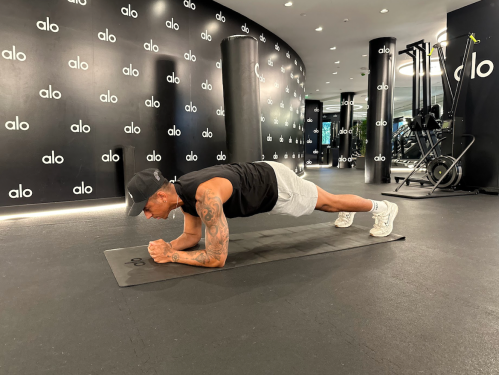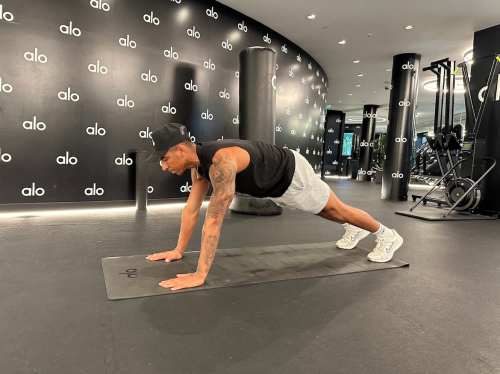If you’re trying to build a stronger core, planks will likely be in heavy rotation in your workouts. “The plank is a great full-body exercise, but especially for the core,” says certified personal trainer Lindsey Bomgren, CPT, founder of Nourish Move Love. When you’re hovering just above the ground in a plank, your entire midsection has to kick in to keep you from collapsing.
Experts in This Article
a certified personal trainer and founder of Nourish Move Love
a certified personal trainer with Alo Moves
There are two main versions of the plank. While some trainers will have you get into a high plank—the position you hit at the top of a push-up—others will have you prop yourself up on your forearms instead.
Both versions are valuable, but they’ll challenge your body slightly differently. Here’s what trainers want you to know about the forearm plank versus high plank, the muscles each version works, and which you should opt for based on your goals and abilities.
Forearm plank
If core strength is what you’re after more than anything else, a forearm plank is the way to go. “As a personal trainer, I love having people get into a forearm plank when we’re focusing on the core specifically,” Bomgren says. “A forearm plank is really going to hit those deep transverse abdominals more.” That’s because your arms are doing a little less work, so your core is forced to step up to stabilize you. You’re also slightly more horizontal to the floor, which is a more challenging position to maintain.
How to do it

- 1.Start on all fours in a tabletop position with your hands and knees on the ground.
- 2.Lower yourself onto your forearms, bending your elbows at 90 degrees, and placing them directly below your shoulders.
- 3.Lift one knee up at a time, placing your weight on your toes with your legs fully extended.
- 4.Maintain a straight line with your whole body, engaging your core.
To get the most out of the move, Bomgren recommends “pushing your heels back toward the wall behind you, spreading your shoulder blades apart, keeping your neck in line [with] a neutral spine, and gazing out over your fingertips.”
If you’re looking for an even more intense core activation, she says to think of pulling your toes toward your elbows. Bonus: “It’s going to instantly pull anyone who has trouble getting their butt down into a nice neutral alignment for a plank,” she says.
Muscles worked
According to Louis Chandler, CPT, a trainer with Alo Moves, “a forearm plank targets all of the core muscles,” plus the shoulders and back. Your lower body will also kick in to keep you lifted above the ground. If you want to get granular, here are the exact muscles you might feel in this position:
- Transversus abdominis (the deepest ab muscles)
- Rectus abdominis (the “six pack”)
- Internal and external obliques (the sides of your trunk)
- Deltoids (shoulders)
- Pectoral muscles (chest)
- Lumbar erector spinae (along the lower spine)
- Quadratus lumborum (deep back muscle)
- Latissimus dorsi (mid back)
- Rhomboids (upper back)
- Glutes (butt)
- Quads (front of thigh)
- Hamstrings (back of thigh)
“As a personal trainer, I love having people get into a forearm plank when we’re focusing on the core specifically. A forearm plank is really going to hit those deep transverse abdominals more.” —Lindsey Bomgren, CPT
Pros
As we mentioned, forearm planks are going to give you a slightly better core workout than high planks. But that’s not the only reason to do them.
If you struggle with traditional planks, getting onto your forearms can sometimes be a more accessible option. “The forearm plank is easier to get into and hold in proper form—it offers more stability and keeps you lower to the ground,” Chandler says.
This variation can also be a lifesaver for anyone with wrist issues, which Bomgren says are especially common among women in particular. “It can be a lot to put full extension on your wrists in a high plank,” she says. “So anyone who complains about wrist pain, forearm plank is a great alternative.”
Cons
Because your arms are bent, forearm plank won’t give you quite as much of an arm workout as you’d get with a traditional plank, according to Chandler. You’re going to need another strategy to get those Popeye biceps.
High plank
So if a traditional plank, or high plank, won’t give you quite as much of a core challenge as a forearm plank, why do people still do it? This classic move will still get your midsection firing (just to a slightly lesser degree), and comes with its own perks, too.
How to do it

- 1.Start on all fours in a tabletop position with your palms directly below your shoulders and your knees on the ground beneath your hips.
- 2.Fully extend one leg then the other directly behind you, stepping onto your toes.
- 3.Push into your palms to straighten your arms.
- 4.Maintain a straight line with your whole body, engaging your core.
Two of the biggest mistakes in this position are dropping the hips too low or hiking them up too high. “If I see people with their butt in the air, I cue ‘pull your toes toward your wrists.’ And if I see people whose butt is sagging or dropping toward the ground, I cue ‘pull your shoulder blades apart,’ and that’s going to bring your hips up,” Bomgren says.
She also suggests thinking of shifting your weight forward to make sure your shoulders are stacked above your wrists. “When we get fatigued, we push back,” she says.
Muscles worked
A high plank will work most of the same muscles as a forearm plank. But Chandler says your arm muscles will also get a challenge, while your core and lower back won’t get quite as fired up. To get specific, here’s what you’ll likely feel activating throughout your body in a traditional plank:
- Transversus abdominis (the deepest ab muscles)
- Rectus abdominis (the “six pack”)
- Internal and external obliques (the sides of your trunk)
- Pectoral muscles (chest)
- Lumbar erector spinae (along the lower spine)
- Quadratus lumborum (deep back muscle)
- Latissimus dorsi (mid back)
- Rhomboids (upper back)
- Triceps (back of upper arm)
- Biceps (front of upper arm)
- Glutes (butt)
- Quads (front of thigh)
- Hamstrings (back of thigh)
“On arm days specifically, if you’re looking for a little bit more of an upper-body workout, high plank is going to get you there.” —Lindsey Bomgren, CPT
Pros
A high plank will work a wider array of upper body muscles than a forearm plank because you’re holding yourself up with straight arms, according to Chandler. “On arm days specifically, if you’re looking for a little bit more of an upper-body workout, high plank is going to get you there,” Bomgren adds.
You can also change the incline more easily with a high plank to decrease the intensity: Bomgren points out that beginners can place their hands on a wall, or you can put them on a chair or bench for a more intermediate-level challenge.
A high plank is also simply a great skill to nail because it’s the basis of other exercises like push-ups, burpees, and renegade rows. Going down to your forearms for those moves simply isn’t an option. “The [high] plank is just such a wide, universally-used move,” Bomgren says.
Cons
Chandler says a traditional high plank can be tough to hold if you’re working on your balance. Your hands don’t give you as much contact with the floor as you get when your entire forearm is down.
Also, if you have wrist pain, this version can be tough. “It puts more strain on your wrists compared to the forearm plank,” Chandler says. Though if you still want to practice high plank despite achy wrists, Bomgren recommends placing your hands on dumbbells or a rolled up yoga mat, giving you a little elevation so they’re less bent, which can take off some of the pressure.
Forearm plank vs. high plank: the bottom line
If core strength is the end-all, be-all goal for you, a forearm plank will give you a bigger burn in your midsection than high plank. It’s also friendlier to your joints. “It helps strengthen your core without putting stress on your wrists,” Chandler says.
However, it can be easier to change up the incline of a high plank to make it more accessible to all fitness levels. And this traditional position is also essential for performing other exercises like push-ups.
Your best option? Do both if you can to get all the benefits. “I think they’re both great to include in a well-rounded exercise routine,” Bomgren says.
But whichever planks you like to do, she suggests striking that pose regularly. “It’s something that should be included in everyone’s weekly workout routine,” she says.
Sign Up for Our Daily Newsletter
Get all the latest in wellness, trends, food, fitness, beauty, and more delivered right to your inbox.
Got it, you've been added to our email list.











